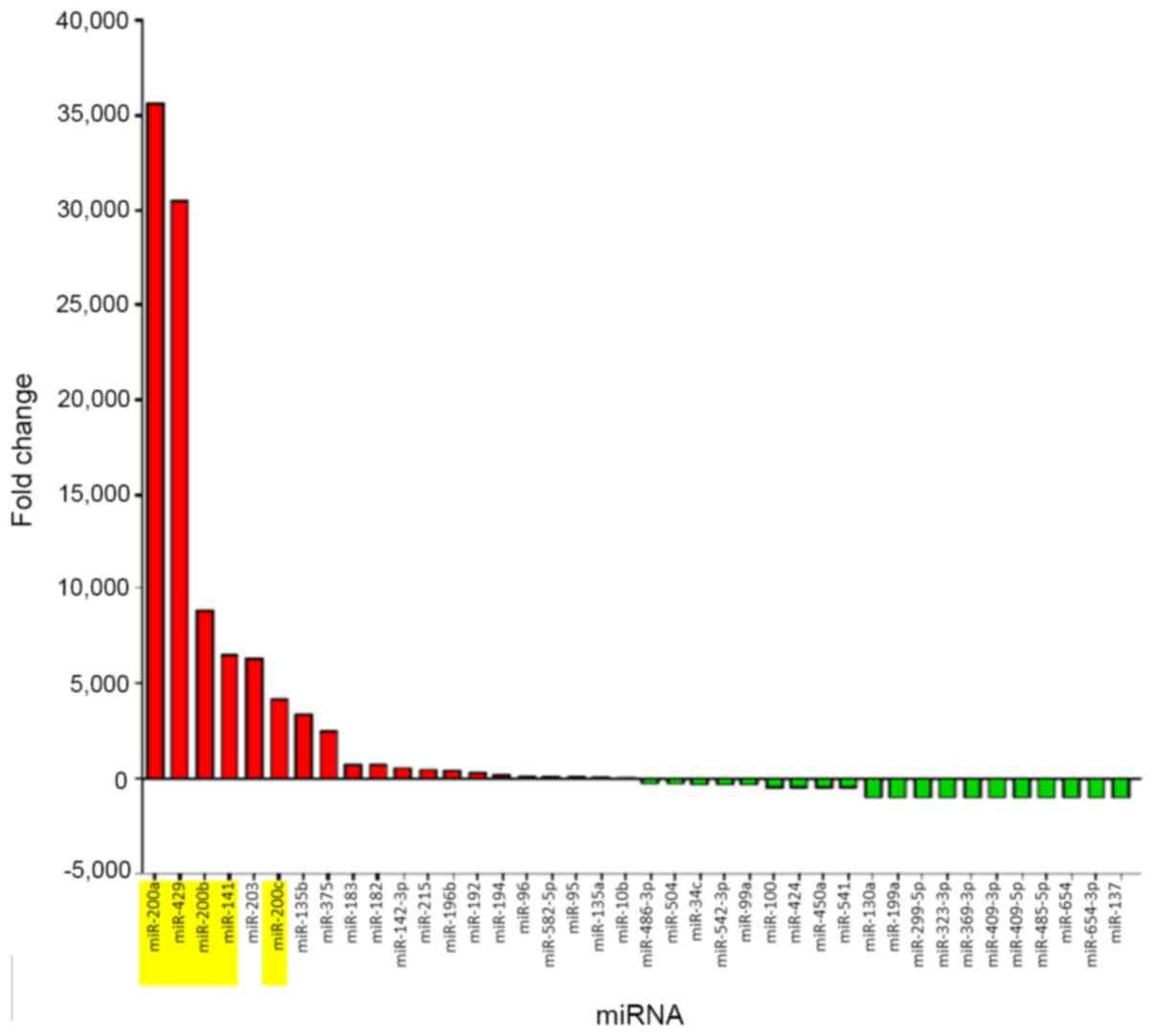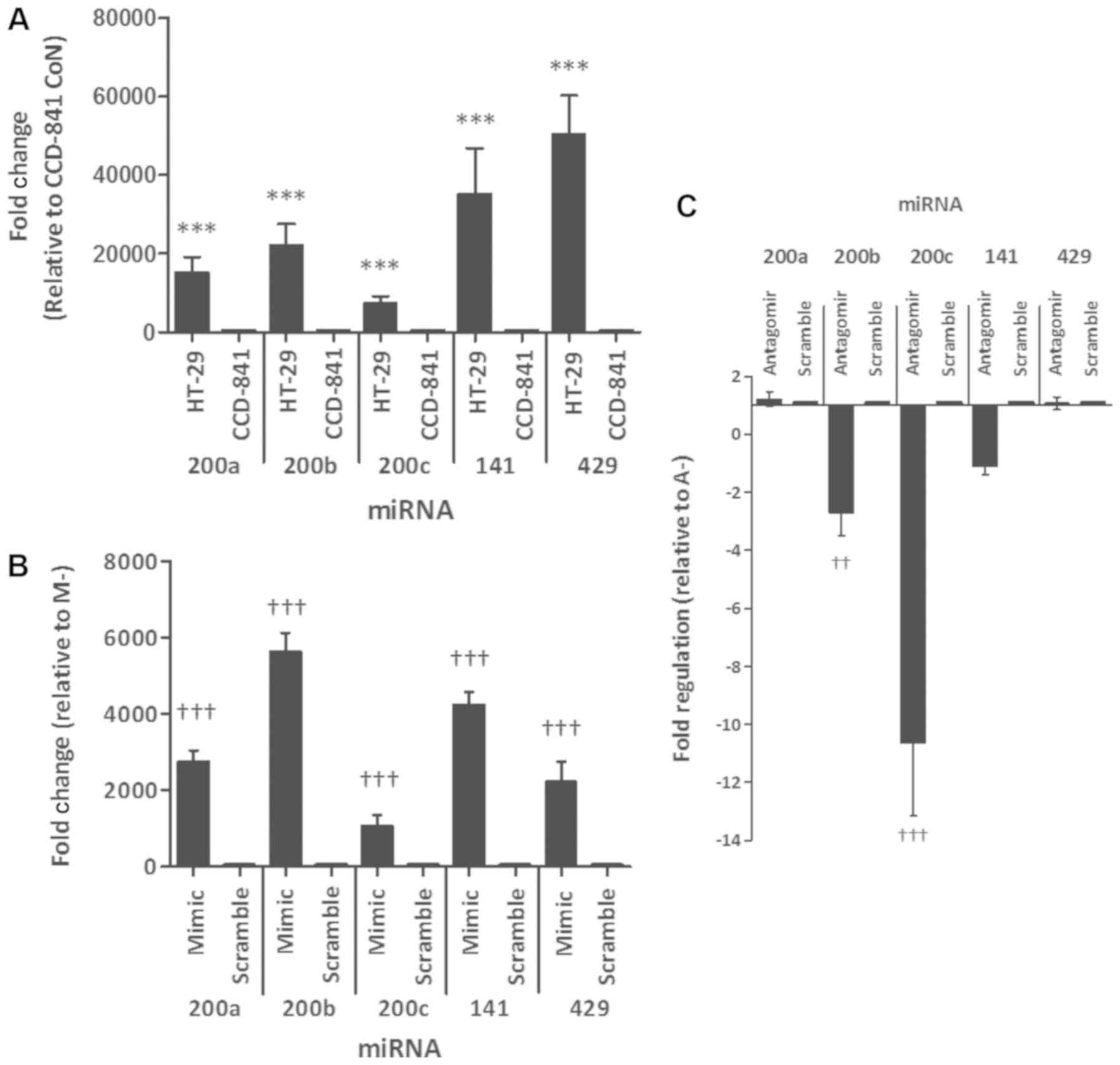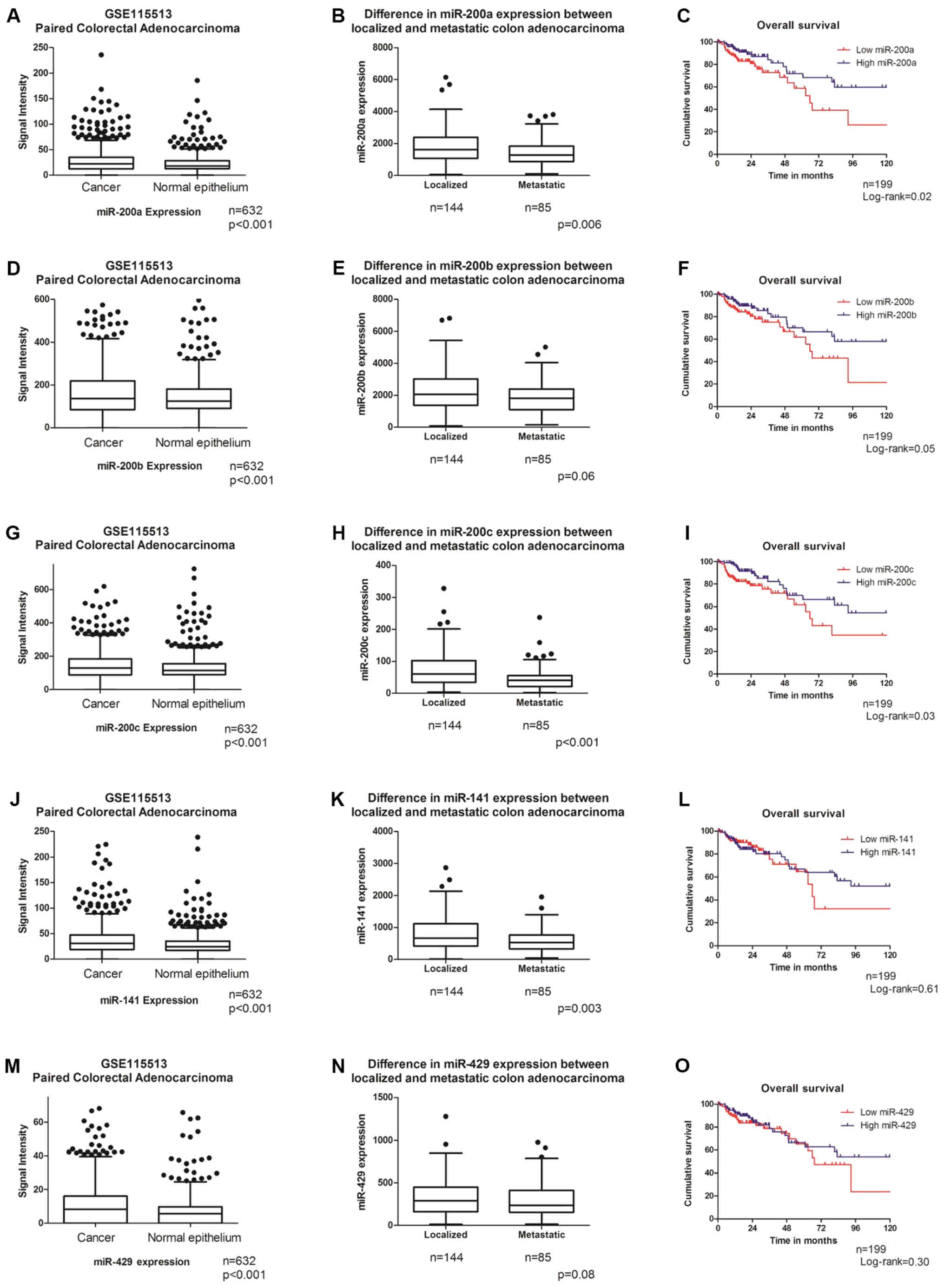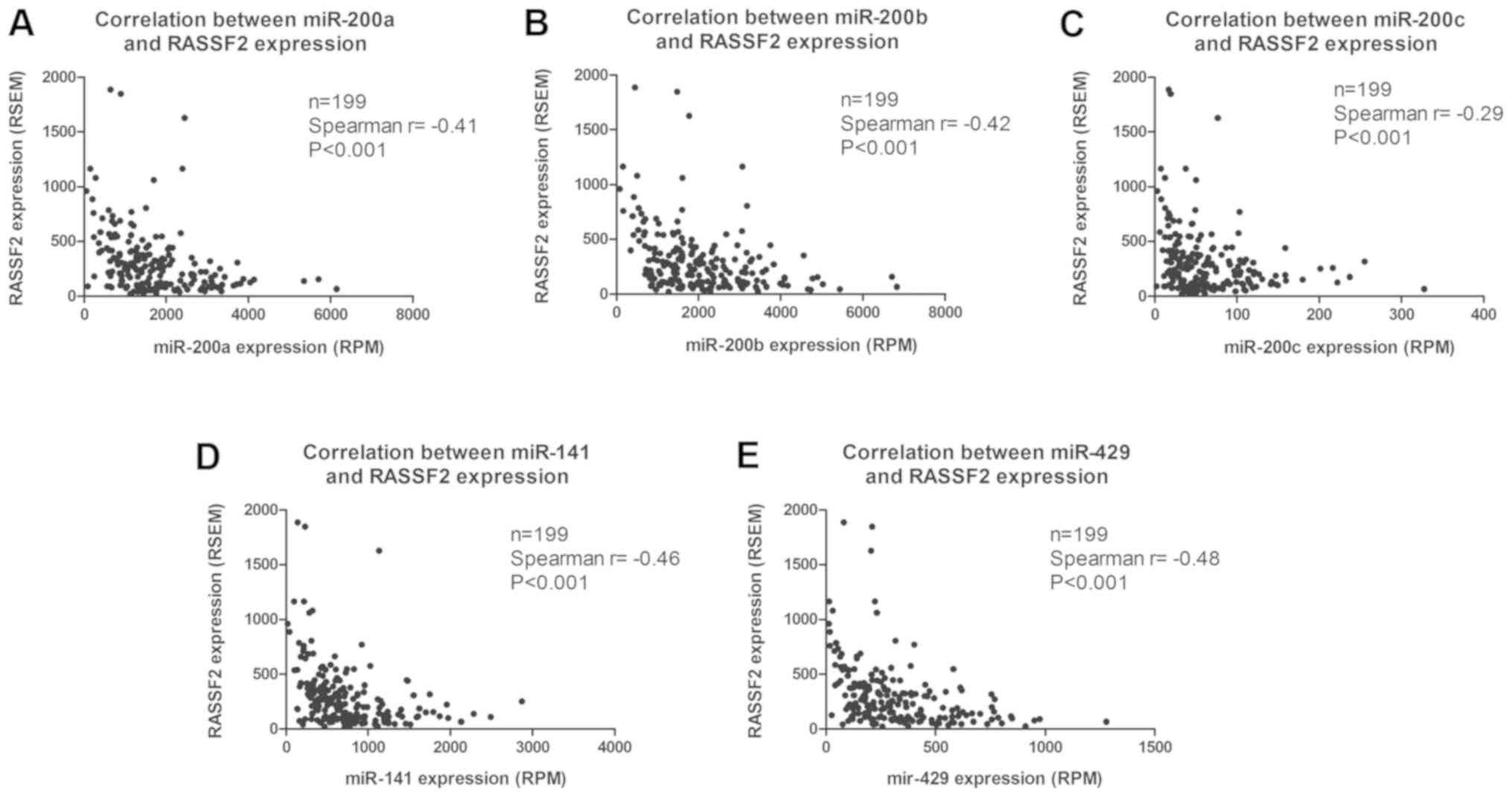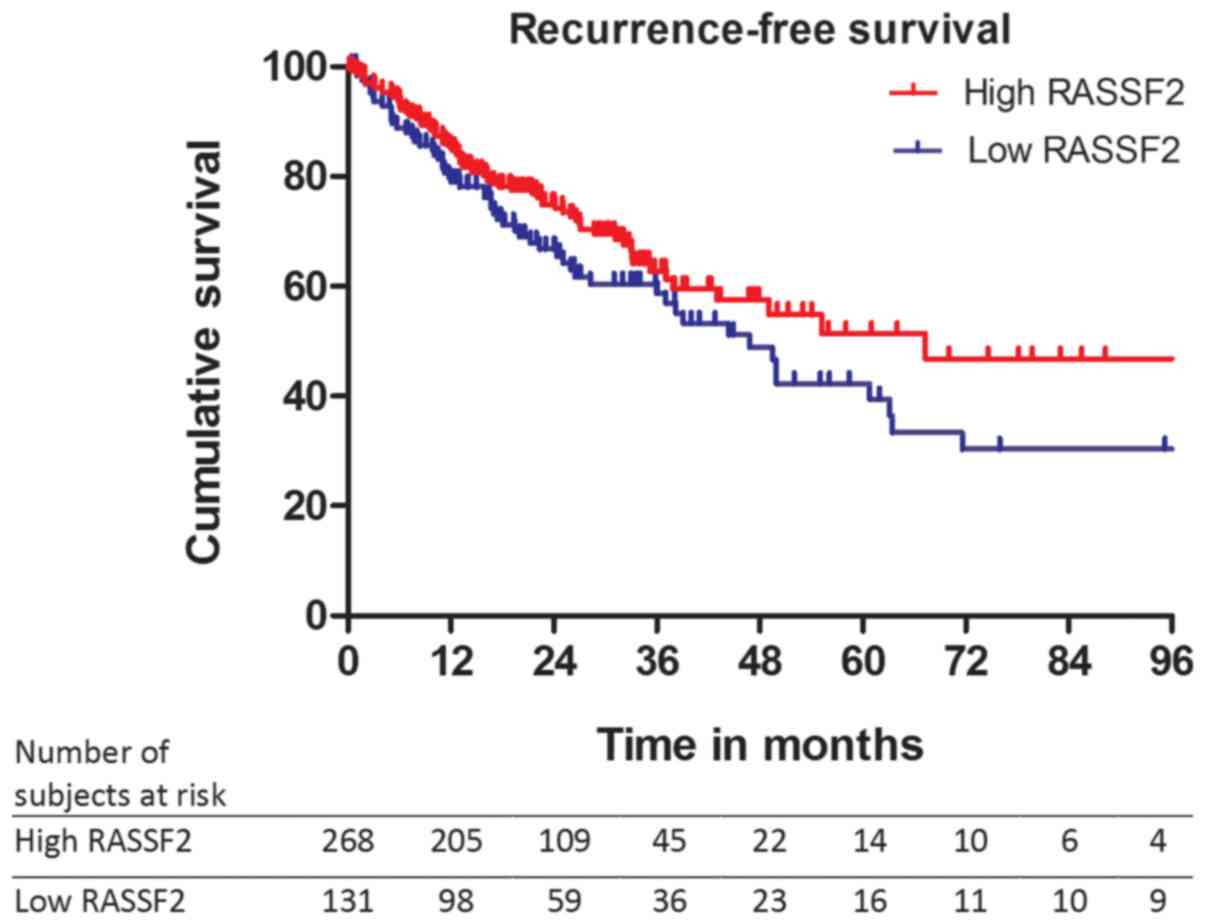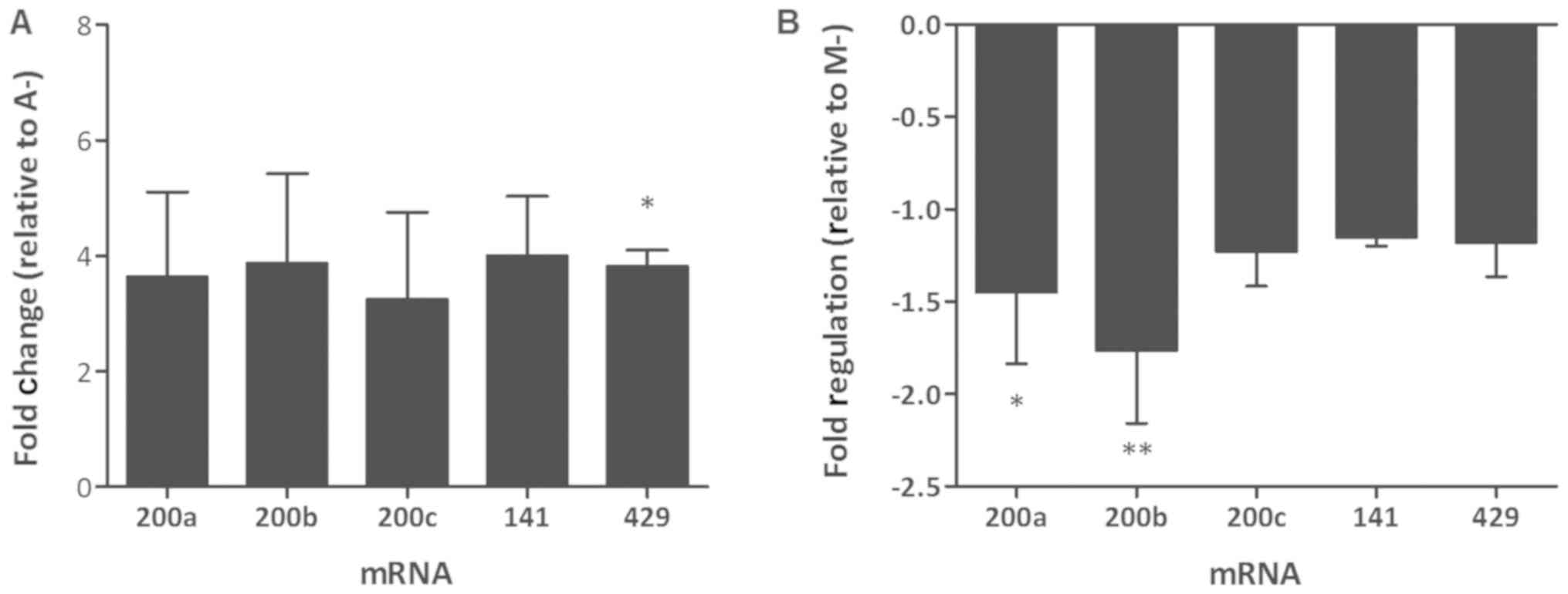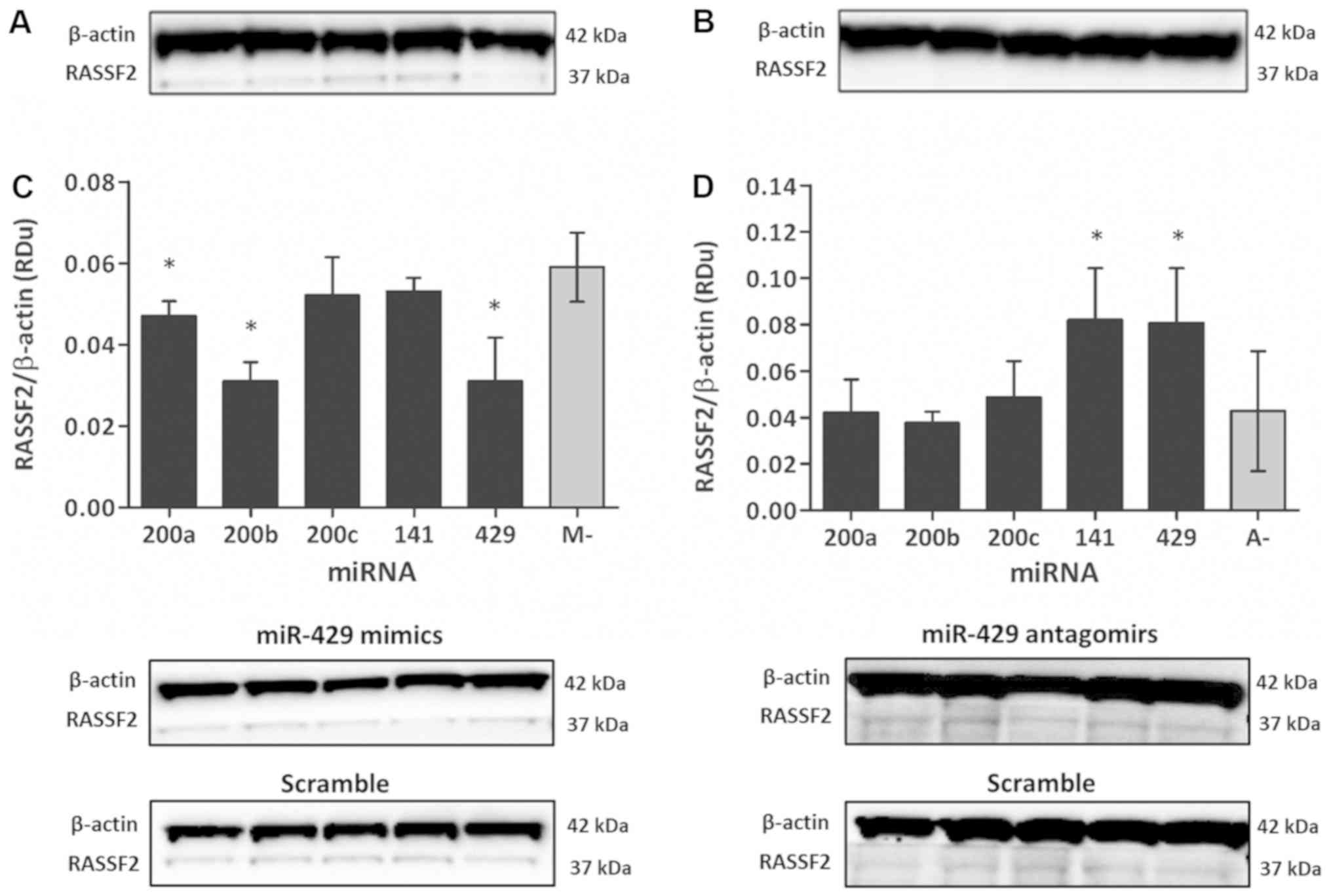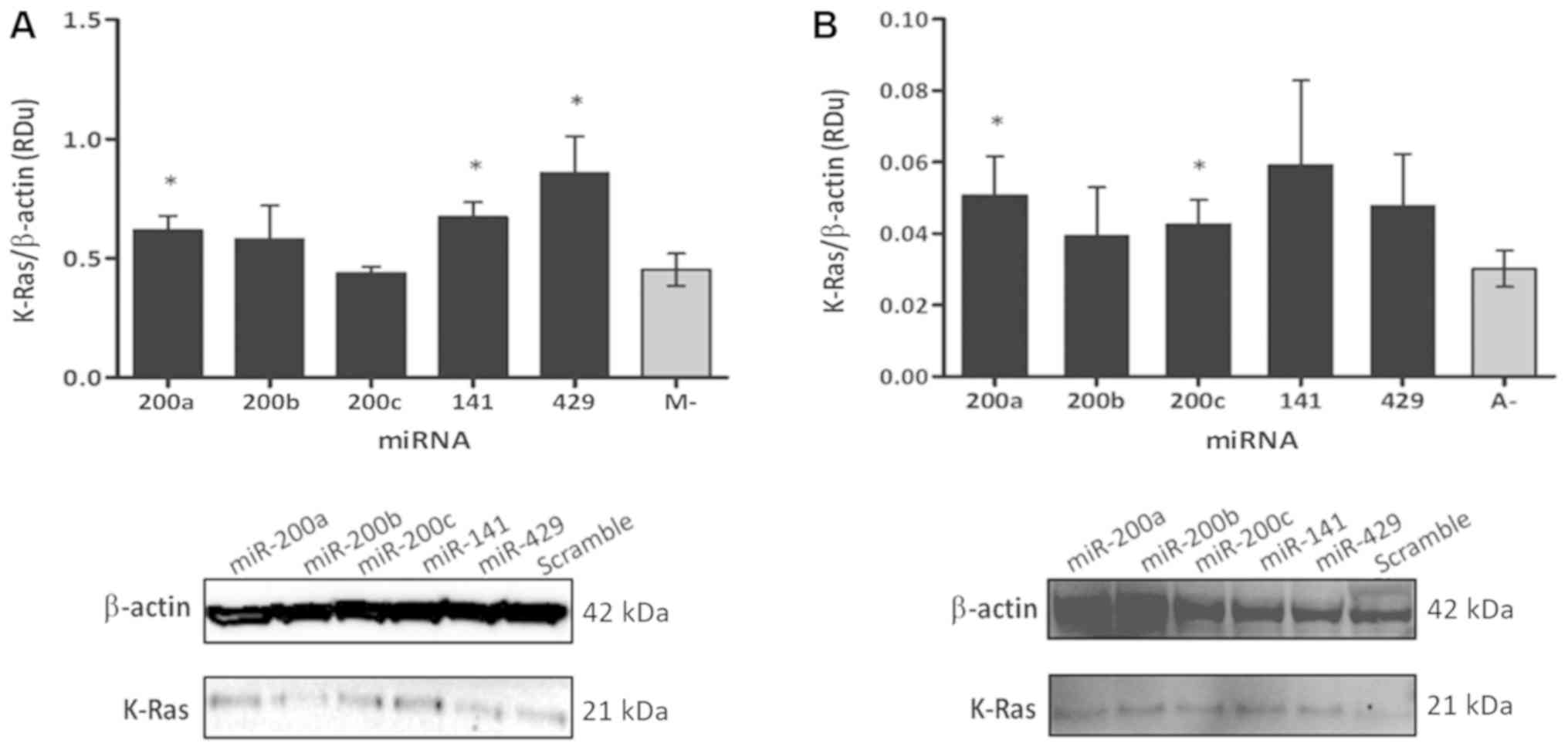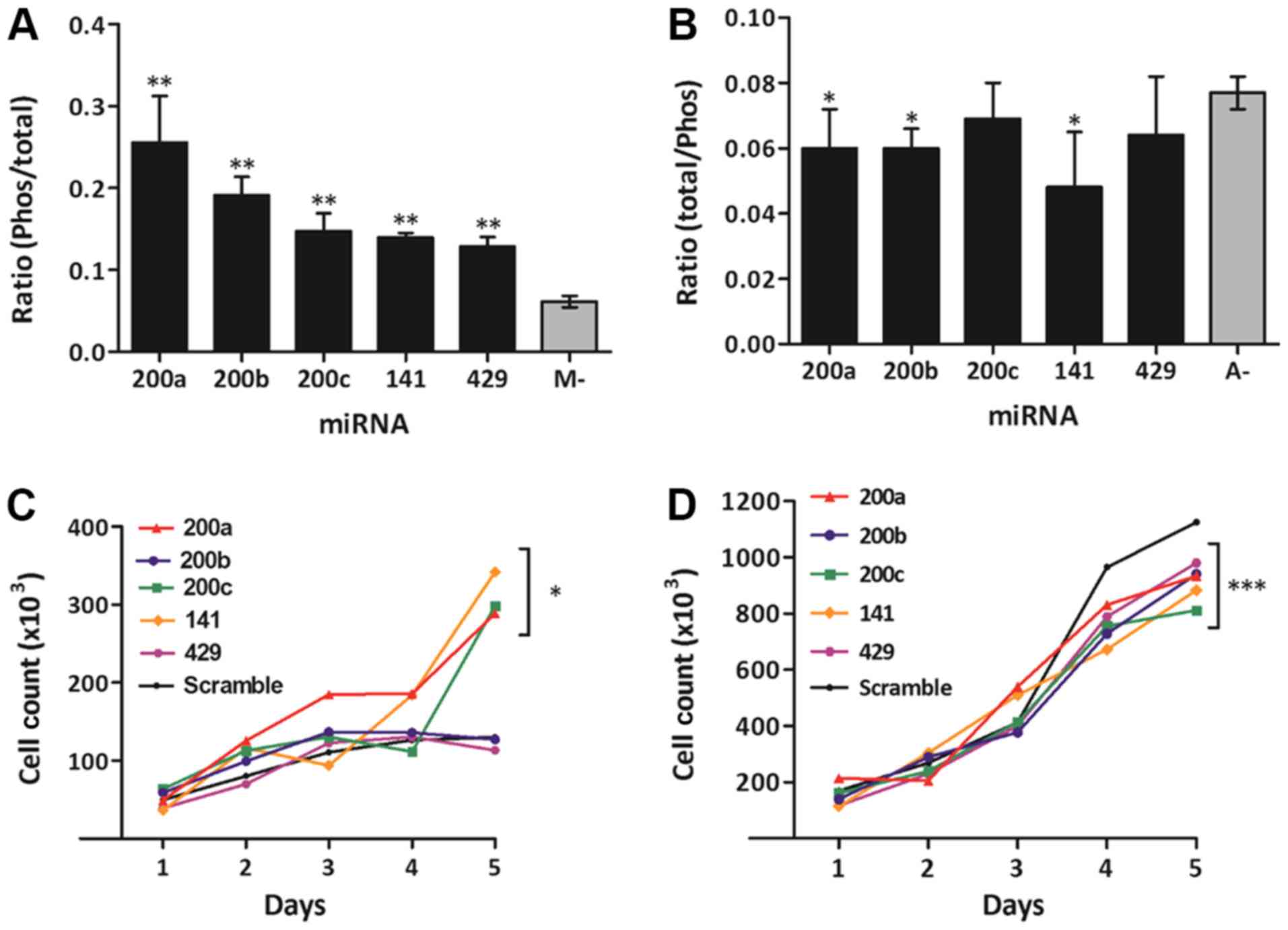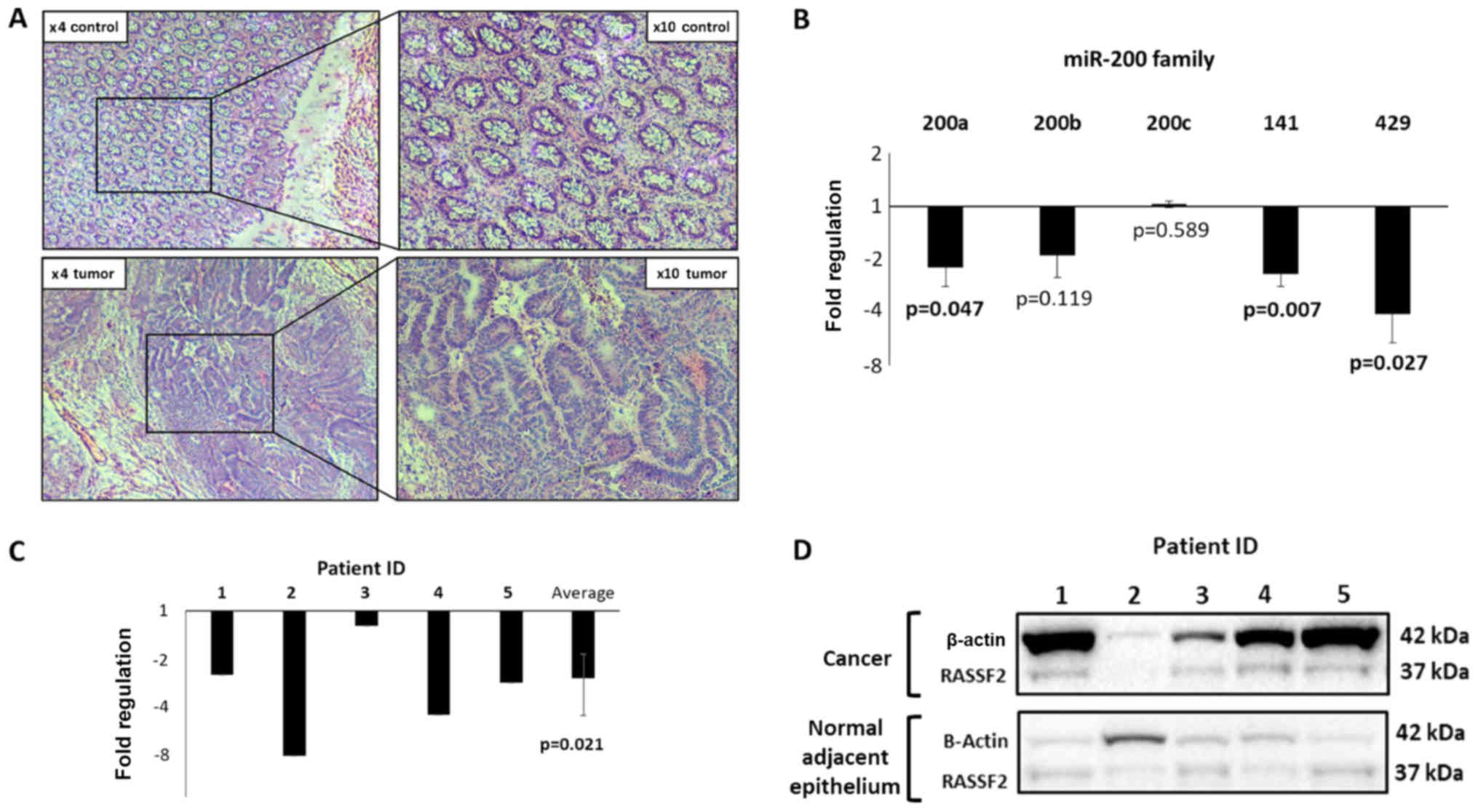Introduction
MicroRNAs (miRNAs) play a crucial role in the
regulation of cell function through specific interactions with
their messenger RNA (mRNA) counterparts. They are small, naturally
occurring, non-protein coding RNA molecules that downregulate gene
expression and affect subsequent protein expression (1,2). miRNAs
exhibit a variety of crucial regulatory functions related to cell
growth, development, and differentiation (3,4). When
miRNAs are overexpressed in cancer, they may function as oncogenes
or tumor suppressors, depending on their target mRNA (5,6).
The miR-200 family consists of five members:
miR-200a, miR-200b, miR-200c, miR-141, and miR-429. The miR-200
family is involved in cell transformation and tumorigenesis, cancer
metastasis, tumor growth, angiogenesis, invasion, migration, and
tumor cell survival in the circulation (intravasation and
extravasation). miR-200 can be a potential diagnostic and
prognostic tool in patients with cancer (7). Differential expression of the miR-200
family is involved in initiation and progression of malignant
transformation. The miR-200 family regulates
epithelial-to-mesenchymal transition (EMT), an important step in
tumor progression (8,9). The majority of cancer studies on the
miR-200 family focus on its role in EMT regulation and tumor
suppression. However, some authors report increased levels of the
miR-200 family in various cancers, which contradicts the tumor
suppressive role of this miRNA family (10).
This study focuses on colorectal cancer (CRC), which
is the third-leading cause of cancer-related deaths in the United
States. The underlying causes of CRC are complex and heterogeneous.
Sporadic CRC is the most common presentation of CRC and develops
from precursor polyps, namely advanced adenomas (11). KRAS mutations have been observed in
35–45% of colorectal adenocarcinomas (12–14).
KRAS acts as a molecular on/off switch within the mitogen-activated
protein kinase (MAPK) pathway, a major regulator of cell
proliferation (15). This MAPK/ERK
pathway is believed to be implicated in the pathogenesis,
progression, and oncogenic behavior of CRC. Kinases within this
pathway have the potential to be used as targets for the treatment
of CRC (16).
It has been shown that the miR-200 family directly
binds Ras association domain family member 2 (RASSF2), a negative
regulator of KRAS (17,18); however, the relationship between
miR-200 family, RASSF2, KRAS, and subsequent activity within the
MAPK/ERK pathway in CRC, has not yet been fully described.
Our aim was to investigate the role of the miR-200
family in relation to MAPK/ERK signaling pathway activity and the
effect upon cell proliferation mediated via the tumor suppressor
RASSF2. We sought to determine whether manipulation of the miR-200
family could influence colon adenocarcinoma cell behavior and
thereby have potential use as a therapeutic target.
Materials and methods
The present study was approved by the University of
Louisville Institutional Review Board. For human studies, tissue
samples were acquired from the University of Louisville Surgical
Biorepository and written informed consent was obtained from all
patients.
Cell line culture
Human colon cell lines, CCD-841 CoN (normal colon
epithelium, cat. no. CRL-1790; ATCC®, Manassas, VA,
USA), HT-29 (colon cancer, cat. no. HTB-38; ATCC®), and
T-84 (colon cancer, cat. no. CCL-248™; ATCC®) were
prepared using the manufacturer's instructions. CCD-841 CoN cells
were grown in Eagle's minimum essential medium. HT-29 cells were
grown in McCoy's 5A. The T84 cell line were grown in Dulbecco's
minimum essential medium supplemented with 15, 10, and 10% fetal
bovine serum, respectively, with a 0.5% mixture of penicillin,
streptomycin, amphotericin B, and 0.5% L-glutamine. Cells were
plated at 250,000 cells/well and allowed to grow to confluence
before being harvested for RNA or protein extraction and stored at
−80°C. Cell lines were tested regularly for mycoplasma and were
authenticated using short tandem repeat analysis
(ATCC®).
miRNA screening
The expression levels of 384 miRNAs were examined in
the HT-29, T-84, and CCD-841 cell lines using TaqMan®
low density array (TLDA) human miRNA card A following the
manufacturer's protocol (Life Technologies, Carlsbad, CA, USA
(19). RT-qPCR was performed using a
ViiA™ 7 real-time PCR system (ThermoFisher Scientific, Inc.,
Middlesex, MA, USA). Expression levels of each individual miRNA
were normalized to RNU6 (endogenous internal reference gene) using
a cycle threshold of 0.1 to calculate ΔCq values for analysis using
the comparative ΔΔCq method. The HT-29 cell line was chosen for
further analysis as it was the most significantly dysregulated from
the T-84 cell line. miRNA expression of the HT-29 cell line was
compared to the miRNA expression of the CCD-841 CoN cell line.
miRNA single assay confirmation
Validation of significantly dysregulated miRNAs
identified from screening was performed using specific
TaqMan® miRNA primers and probes with RT-qPCR (Life
Technologies, Carlsbad, CA, USA). Nucleic acid quantification was
performed using a Step-One Plus RT-qPCR system (Life Technologies).
The levels of each individual miR-200 family member (hsa-miR-429,
cat. no: 4427975/assay ID: 001024, hsa-miR-200c, cat. no:
4427975/assay ID: 002300, hsa-miR-200b, cat. no: 4427975/assay ID:
002251, hsa-miR-200a cat. no: 4,427,975/assay ID: 000502,
hsa-miR-141 cat. no: 4427975/assay ID: 000463) were normalized to
RNU6 (cat. no: 4427975/assay ID: 001973) for each cell line using a
cycle threshold of 0.1 to calculate ΔCq values for analysis using
the comparative ΔΔCq method (20).
All reactions were completed in duplicate.
Bioinformatic analysis
Targets of the miR-200 family were screened using
Ingenuity Pathway Analysis (Qiagen, Hilden Germany.) This program
uses publicly available datasets and the scientific literature to
identify dysregulated pathways in diseases and potential gaps in
molecular signaling. The identified molecular interactions were
investigated and verified using mirTarBase (21). The predicted binding between the
miR-200 family and RASSF2 has previously been experimentally
verified using dual-luciferase reporter assay and Northern blotting
(22). The results of this study
demonstrate the direct binding interaction between the miR-200
family and RASSF2.
The Cancer Genome Atlas and microarray
datasets
The RNA-seq expression data for RASSF2 and
microRNA-seq expression data for the miR-200 family in patients
with colon adenocarcinoma was downloaded from cbioportal
(http://www.cbioportal.org/accessed
10/01/2018). The microRNA-seq expression data for the same patients
with colon adenocarcinoma was downloaded from Firebrowse
(http://firebrowse.org/ accessed 11/20/18). The
associated clinical dataset was downloaded from The Cancer Genome
Atlas (TCGA, http://portal.gdc.cancer.gov/). The GSE115513
microarray normalized dataset was downloaded from Gene Expression
Omnibus. The paired tumor and normal adjacent tissue datasets were
extracted.
Reverse transcription (RT) and
quantitative real-time polymerase chain reaction (RT-qPCR)
Isolation of total RNA from cell lysates was
performed using the Ambion® miRVana miRNA isolation kit
(Life Technologies). Quantitation of total RNA quantity and quality
was determined using a Nanodrop 2000 spectrophotometer
(ThermoFisher Scientific, Inc.). Complementary DNA (cDNA) was
generated from 10 ng total RNA samples using the TaqMan®
miRNA reverse transcription kit (Life Technologies). qPCR was
performed using 1.33 µl of cDNA and TaqMan® microRNA
assays (Life Technologies). Reactions were run in duplicate.
mRNA quantification
For mRNA quantification, total RNA was converted to
cDNA using a high-capacity cDNA reverse transcription kit (Life
Technologies) with random nucleotide primers. Specific
TaqMan® probes for RASSF2 (cat. no:
4331182/Hs00248129_m1) and 18S (cat. no: 4331182/Hs03928990_g1)
(endogenous internal reference gene) were used during RT-qPCR. All
reactions were completed in duplicate. Nucleic acid quantification
was performed using a Step-One Plus RT-qPCR system (Life
Technologies). The expression levels of RASSF2 mRNA were normalized
to 18S using a cycle threshold of 0.1 to calculate ΔCq values for
analysis using the comparative ΔCq method.
miRNA transfection
Each cell line was transfected with each individual
member of the miR-200 family. Scrambled oligonucleotides served as
a negative control using mirVana™ miRNA mimics (for CCD-841 CoN)
and antagomirs (for HT-29) (Life Technologies). Once plated, cells
were allowed a 24-h acclimation period to adhere to the plate prior
to transfection. After 24 h, when cells were 60–80% confluent in
each well, they were transfected using Lipofectamine®
RNAiMAX transfection reagent (Life Technologies), according to the
manufacturer's protocol.
Immunoblotting
Cells were lysed using radio immune-precipitation
assay (RIPA) buffer and the protein concentration determined using
the bicinchoninic acid (BCA) assay. Forty micrograms of total
protein from each cell lysate was separated by NuPAGE®
MOPS SDS and transferred on to a nitrocellulose membrane. The
primary antibodies used were RASSF2 EPR6621 (1:1,000; Abcam) and
β-actin (1:10,000; Cell Signaling Technology). Secondary antibodies
used were HRP-conjugated goat anti-rabbit and horse anti-mouse IgG
(1:1,000; Cell Signaling Technology). The membrane was incubated in
equal parts of enhanced chemiluminescence (ECL) reagents A and B
for 5 min in the dark to detect the target protein, and then
developed and imaged using a ChemiDoc MP imager (BioRad, Hercules,
CA, USA).
Enzyme-linked immunosorbent assay
Cells were seeded in 6-well plates (250,000
cells/well) and transfected as previously described. After 24 h,
cell sample lysates were harvested with cell lysis mix and protein
concentration determined using the BCA assay. Fifty microliters of
cell lysate and 50 µl of pre-prepared antibody cocktail mix were
added into an InstantOne™ ELISA 96 well plate (Affymetrix, Santa
Clara, CA, USA), according to the manufacturer's protocol. Total
and phosphorylated ERK1/2 levels were measured by reading the
absorbance of the samples using the SPECTRAmax® PLUS 384
microplate spectrophotometer at a wavelength of 450 nm.
Cell proliferation assay
HT-29 and CCD-841 CoN cells were plated in duplicate
at a concentration of 100,000 cells/ml and 50,000 cells/ml in
individual wells in 12-well plates, respectively. After 24 h, cells
were serum-starved in 0.5% FBS for 2 h before replacement of normal
growth medium and then transfected with miRNA mimics and antagomirs
as previously described. Transfection was stopped after 24 h, and
cells were trypsinized. A 10 µl sample from each well was inserted
into a dual chamber counting slide (Bio-Rad), and the cell number
was measured daily for 5 days using an automated cell counter
(TC20™, Bio-Rad).
Human tissue
Fresh frozen tissue samples of colon cancer and
normal adjacent colon epithelial tissue, which was taken at least
10 cm from the primary lesion from five patients diagnosed with
stage III adenocarcinoma were obtained from the University of
Louisville surgical biorepository.
Laser capture microdissection
Tissue serial sections were cut at 7-µm thickness,
mounted, and stained using the Histogene™ LCM frozen section
staining kit. One slide stained with hematoxylin and eosin per
sample was used as reference. Colon cancer and normal adjacent
colon epithelial tissue were identified and laser captured using
the ArcturusXT™ laser capture microdissection system. RNA was
extracted and isolated using the Arcturus®
PicoPure® frozen RNA isolation kit. RT and RT-qPCR for
the miR-200 family and RASSF2 was performed. Protein was extracted
and RASSF2 measured via western blot analysis as previously
described.
Statistical analysis
For each cell line and transfected miRNA, samples
were prepared in replicates of five unless otherwise stated. Cell
culture samples were grown from new freezes and transfected at the
same passage to maintain a true sample size of five. All reactions
were run in duplicate, and averages of the duplicates were used for
analysis. The chi-squared test or Fischer exact test, where
appropriate, were used to compare categorical variables. The
independent Student's t-test or Mann-Whitney U test was used to
compare continuous non-paired variables. The difference in paired
continuous data was done with the Wilcoxon signed-rank test. For
tests with multiple comparisons, a repeated measures analysis of
variance with post hoc Bonferroni correction was performed. The
difference in overall and recurrence-free survival were assessed by
Kaplan-Meier survival analysis and the log rank test. Univariable
and multivariable Cox regression analyses were done to identify
risk factors for a reduced overall survival. Correlation between
mRNA and miRNA expression was analyzed with Spearman Rank
correlation test. Statistical analysis was performed using the
Statistical Package for the Social Sciences (SPSS) v25.0 (IBM Corp,
Armonk, NY, USA). Graphs were prepared using GraphPad Prism v6.01
(GraphPad Software, Inc., La Jolla, CA, USA). P<0.05 was
considered to indicate a statistically significant difference. Data
are presented as mean ± standard deviation (SD).
Results
miR-200 family expression is increased in
colorectal cancer and is increased in localized cancer compared
with metastatic cancer
In vitro studies
To verify that the miR-200 family was upregulated in
an in vitro model, we screened for the expression of 384
miRNAs, using TLDA miRNA arrays cards in the human colon
adenocarcinoma cell lines HT-29 and T-84 compared with a normal
colon epithelial (CCD-841 CoN) cell line (Fig. 1). The miR-200 family was the most
significantly upregulated. As the HT-29 cell line showed the
greatest differential expression of the miR-200 family as compared
with the normal colon epithelial cell line and is known to
demonstrate an epithelial phenotype (23), it was chosen for further study. These
data were confirmed on single assay analysis. Comparison between
the HT-29 and CCD-841 CoN cell lines showed elevated levels of
miR-200a, miR-200b, miR-200c, miR-141, and miR-429 in HT-29 samples
(P<0.0001; Fig. 2A). miR-200
family expression in cells was increased or suppressed by
transfection with individual miRNA mimics (CCD-841 CoN)
(P<0.001) or antagomirs (HT-29) [miR-200b P<0.01, miR-200c
P<0.001, (Fig. 2B and C)].
Studies using data from human
biorepositories
Using the paired microRNA microarray GSE115513
dataset (n=632), all members of the miR-200 family were increased
in colorectal cancer compared with paired normal adjacent colon
epithelium (all P<0.001; Fig. 3).
As the miR-200 family is known to have a role in cancer
progression, the miR-200 family expression was examined between
localized (stage I and II) and metastatic (stage III and IV) colon
adenocarcinoma microRNA-seq dataset derived from TCGA [(n=229);
Fig. 3]. Using the median expression
as a cut-off, miR-200a (P=0.006), miR-200c (P<0.001), and
miR-141 (P=0.003) were all significantly increased in localized
cancer compared with metastatic cancer. Additionally, miR-200b
(P=0.06) and miR-429 (P=0.08) had a significant trend towards
increased expression in localized cancer compared with metastatic
cancer. As expected, low miR-200a (log-rank=0.02), mirR-200b
(log-rank=0.05), and miR-200c (log-rank=0.03) expression were
significantly associated with worse overall survival. miR-429
(P=0.61) and miR-141 (P=0.30) were not associated with worse
overall survival (Fig. 3). Low
cancer tissue miR-200a, low miR-200b, and low miR-200c expression
were significantly associated with advanced stage disease (Table I). On univariable and multivariable
analysis, low tumor miR-200a, low miR-200b, and low miR-200c were
all significant predictors of shorter overall survival (Table II). Individual multivariable Cox
regression models were used due to the expected significant
collinearity between members of the miR-200 family.
 | Table I.Clinicopathological variables for
patients with colon adenocarcinoma in the Cancer Genome Atlas
dataset. |
Table I.
Clinicopathological variables for
patients with colon adenocarcinoma in the Cancer Genome Atlas
dataset.
| Variables | Total (n=199) | Localized disease
(n=114) | Metastatic disease
(n=85) |
|---|
| Age, years (median,
IQR) | 66 (56–75) | 69 (58–77) | 64 (52–73) |
| Sex |
|
Male | 112 (56) | 67 (59) | 45 (53) |
|
Female | 87 (44) | 47 (41) | 40 (47) |
| Race |
|
Caucasian | 162 (85) | 93 (86) | 69 (83) |
|
African-American | 29 (15) | 15 (14) | 14 (17) |
| Anatomical
location |
|
Cecum | 54 (29) | 29 (27) | 25 (31) |
|
Ascending colon | 38 (2) | 26 (24) | 12 (15) |
| Hepatic
flexure | 13 (7) | 6 (6) | 7 (9) |
|
Transverse colon | 14 (7) | 8 (7) | 6 (7) |
| Splenic
flexure | 4 (2) | 3 (3) | 1 (1) |
|
Descending colon | 10 (5) | 5 (5) | 5 (6) |
| Sigmoid
colon | 56 (30) | 30 (28) | 26 (32) |
| Lymphatic
invasion |
|
Yes | 48 (27) | 7 (7) | 41 (55) |
| No | 130 (73) | 96 (93) | 34 (45) |
| Venous
invasion |
|
Yes | 38 (22) | 7 (7) | 44 (59) |
| No | 137 (78) | 93 (93) | 31 (41) |
| Perineural
invasion |
|
Yes | 36 (29) | 15 (21) | 21 (39) |
| No | 88 (71) | 55 (79) | 33 (61) |
| miR-200a |
|
Low | 100 (50) | 49 (43) | 51 (60) |
|
High | 99
(50) | 65 (57) | 34 (40) |
| miR-200b |
|
Low | 100 (50) | 51 (45) | 49 (58) |
|
High | 99
(50) | 63 (55) | 36 (42) |
| miR-200c |
|
Low | 100 (50) | 45 (40) | 55 (65) |
|
High | 99
(50) | 69 (60) | 30 (35) |
| miR-141 |
|
Low | 100 (50) | 47 (41) | 53 (62) |
|
High | 99
(50) | 67 (59) | 32 (38) |
| miR-429 |
|
Low | 100 (50) | 53 (47) | 47 (55) |
|
High | 99
(50) | 61 (54) | 38 (45) |
 | Table II.Univariable and multivariable Cox
regression analysis for risk factors associated with overall
survival. |
Table II.
Univariable and multivariable Cox
regression analysis for risk factors associated with overall
survival.
|
| Univariable
analysis | Multivariable
analysis- Model 1 | Multivariable
analysis- Model 2 | Multivariable
analysis- Model 3 |
|---|
|
|
|
|
|
|
|---|
| Variable | HR | 95% CI | P-value | HR | 95% CI | P-value | HR | 95% CI | P-value | HR | 95% CI | P-value |
|---|
| Age >66
years | 2.405 | 1.236–4.678 | 0.006a | 2.274 | 1.057–4.893 | 0.036a | 2.3 | 1.080–4.897 | 0.031a | 2.535 | 1.193–5.385 | 0.016a |
| Sex-female | 0.569 | 0.304–1.065 | 0.078 | 1.304 | 0.627–2.719 | 0.477 | 1.533 | 0.759–3.097 | 0.234 | 1.509 | 0.753–3.024 | 0.246 |
| Race | 0.733 | 0.260–2.062 | 0.556 |
|
|
|
|
|
|
|
|
|
| Tumor location |
|
|
|
|
|
|
|
|
|
|
|
|
|
Cecum | 1 |
|
|
|
|
|
|
|
|
|
|
|
|
Ascending colon | 0.967 | 0.422–2.216 | 0.937 |
|
|
|
|
|
|
|
|
|
| Hepatic
flexure | 0.812 | 0.234–2.816 | 0.743 |
|
|
|
|
|
|
|
|
|
|
Transverse colon | 0.523 | 0.119–2.295 | 0.391 |
|
|
|
|
|
|
|
|
|
| Splenic
flexure | 1.006 | 0.132–7.679 | 0.995 |
|
|
|
|
|
|
|
|
|
|
Descending colon | 0 | 0.000-infinity | 0.975 |
|
|
|
|
|
|
|
|
|
| Sigmoid
colon | 0.807 | 0.370–1.761 | 0.59 |
|
|
|
|
|
|
|
|
|
| Lymphatic
invasion | 1.74 | 0.845–3.583 | 0.133 |
|
|
|
|
|
|
|
|
|
| Venous
invasion | 1.962 | 0.962–4.000 | 0.064 | 1.297 | 0.598–2.816 | 0.51 | 1.192 | 0.536–2.650 | 0.666 | 1.218 | 0.555–2.672 | 0.623 |
| Perineural
invasion | 1.475 | 0.627–3.469 | 0.373 |
|
|
|
|
|
|
|
|
|
| Metastatic
disease | 1.838 | 1.015–3.331 | 0.045a | 2.224 | 1.082–4.571 | 0.030a | 2.308 | 1.118–4.763 | 0.024a | 2.017 | 0.976–4.168 | 0.058 |
| Low miR-200a | 2.013 | 1.091–3.715 | 0.025a | 2.009 | 1.001–4.031 | 0.05 |
|
|
|
|
|
|
| Low miR-200b | 1.804 | 0.983–3.311 | 0.057 |
|
|
| 1.851 | 0.947–3.618 | 0.072 |
|
|
|
| Low miR-200c | 1.974 | 1.076–3.621 | 0.028a |
|
|
|
|
|
| 2.051 | 1.022–4.113 | 0.043a |
| Low miR-141 | 1.156 | 0.620–2.154 | 0.648 |
|
|
|
|
|
|
|
|
|
| Low miR-429 | 1.369 | 0.752–2.491 | 0.304 |
|
|
|
|
|
|
|
|
|
miR-200 family targets the tumor
suppressor RASSF2
Utilizing microarray screening data, Ingenuity
Pathway Analysis (Qiagen, Hilden, Germany) identified relevant
miRNAs and associated pathways. The MAPK/ERK signaling pathway was
the pathway most closely linked to the colon cancer cell line
screening data. All members of the miR-200 family were
significantly enriched within this pathway (Fig. S1). miRTarBase identified all five
miR200 family miRNAs (miR-200a, miR-200b, miR-200c, miR-141,
miR-429) to target the same gene, RASSF2. The miR-200 family
previously has been demonstrated to directly bind RASSF2 using
dual-luciferase reporter assay and Northern blotting (22). Expression of all members of the
miR-200 family was significantly inversely correlated with that of
RASSF2 using TCGA dataset (Fig. 4).
Decreased RASSF2 expression was associated with a trend towards a
worse recurrence-free survival (P=0.058; Fig. 5).
miR-200 family expression can regulate
RASSF2 mRNA expression
RASSF2 mRNA expression was significantly decreased
in HT-29 cells as compared with CCD-841 CoN (fold regulation −6282,
P<0.001). Knock down of the miR-200 family in HT-29 cells
led to increased RASSF2 mRNA expression in the HT-29 cell line
significantly for miR-429 with a fold change of 3.82 (P<0.001;
Fig. 6A). Overexpression of
the miR-200 family in CCD-841 CoN cells led to a decreased RASSF2
mRNA expression. miR-200a and miR-200b mimics significantly
downregulated RASSF2 mRNA (fold regulation= −1.45, P=0.01, and fold
regulation= −1.74, P<0.001; Fig.
6B).
miR200 family expression can regulate
RASSF2 protein expression
The change in RNA expression was verified by
examining RASSF2 protein expression. RASSF2 protein was present in
CCD-841 CoN cells, whereas no RASSF2 protein was detected in the
HT-29 cell line (Fig. 7A and B).
Transfection with miR-200 family member mimics led to a decreased
trend in RASSF2 protein expression in the CCD-841 CoN cell line.
RASSF2 protein levels were significantly lower in CCD-841 CoN cells
when transfected with miR-200a, miR-200b, miR-429 mimics
(P<0.05; Fig. 7C). Increased
expression of RASSF2 protein expression was observed in the HT-29
cell line with transfection of miR-141 and miR-429 antagomirs
(P<0.05; Fig. 7D).
miR-200 family can regulate activity
in the MAPK/ERK pathway
Transfection with miR-200 family mimics led to an
increased trend in KRAS protein expression in the CCD-841 CoN
cells. There were significant increases observed with miR-200a,
miR-141, and miR-429 (P<0.05; Fig.
8A). Transfection with miR-200 family antagomirs led to KRAS
protein in the HT-29 cells, and there were significant increases
observed with miR-200a and miR-200c knockdown (P<0.05; Fig. 8B). The normalized expression of KRAS
in the HT-29 cells was 10-fold lower than that of the CCD-841
cells, which suggests there was low endogenous expression of KRAS.
Subsequent activity within the MAPK pathway was measured by ERK
phosphorylation compared with total ERK1/2 levels. There was an
increased ratio of phosphorylated-to-total ERK 1/2 with
transfection of miR-200 family mimics in the CCD-841 cell line (all
P<0.01; Fig. 9A). There was a
decreased trend in the ratio of phosphorylated-to-total ERK1/2 in
the HT-29 cell line with transfection of miR-200 family antagomirs.
There was a significant decrease in the ratio of
phosphorylated-to-total ERK1/2 with transfection of miR-200a,
miR-200b, and miR-141 antagomirs (P<0.05; Fig. 9B). These results indicate that the
miR-200 family can regulate MAPK/ERK pathway activation, in part,
through KRAS regulation.
miR-200 family expression can regulate
cell proliferation
As the MAPK/ERK pathway is a major regulator of
cellular growth, cell proliferation was measured to analyze the
functional effect of MAPK/ERK pathway regulation by the miR-200
family. Transfection with miR-200a, miR-200c, and miR-141 mimics
led to increased cell proliferation in CCD-841 cells (P<0.05;
Fig. 9C). Transfection with miR-200
antagomirs led to decreased cell proliferation in HT-29 cells (all
P<0.001; Fig. 9D).
Laser capture microdissection of colon
cancer tissue for miR-200 family, RASSF2 mRNA, and RASSF2 protein
expression
A laser capture microdissection system was used to
selectively dissect paired cancer tissue and normal epithelium from
patients with stage III colon adenocarcinoma (Fig. 10A). There was downregulation of
miR-200a (P=0.047), miR-200b (P=0.119), miR-141 (P=0.007), and
miR-429 (P=0.027), with no difference in miR-200c (P=0.589) in
colon cancer tissue samples compared with normal adjacent
epithelium (Fig. 10B). These
results reflect the data seen in the previous sequencing datasets,
where the miR-200 family was downregulated in metastatic disease.
There was a 2.7-fold downregulation of RASSF2 mRNA in the cancer
tissue compared with colon epithelium (P=0.021; Fig. 10C), and a 6-fold downregulation of
RASSF2 protein in colon cancer tissue relative to normal adjacent
epithelium (P=0.092; Fig. 10D).
Discussion
This study describes the role of the miR-200 family
in the regulation of RASSF2 and the subsequent downstream effect
upon the MAPK/ERK signaling pathway. All members of the miR-200
family were significantly increased in colon cancer tissue compared
with paired normal adjacent colon epithelium. Interestingly, there
was a progressive decrease in miR-200 family expression in
metastatic colon cancer compared with localized cancer. The
significance of the miR-200 family in colon cancer was further
highlighted in a screening miRNA array, where it was the most
upregulated group of miRNA compared with normal colon cells.
Pathway analysis software and a previous study identified that the
miR-200 family directly binds RASSF2 (22). We further demonstrated this by
showing a significant inverse correlation between all members of
the miR-200 family and RASSF2. Transfection with miR-200 family
mimics, and antagomirs could regulate cell proliferation, in part,
by directly regulating RASSF2 expression and subsequently
increasing MAPK/ERK pathway signaling through KRAS.
Although miR-200 family knockdown led to an
increased trend in RASSF2 expression and induced activation of the
MAPK/ERK signaling pathway, it increased KRAS expression in the
HT-29 cell line. This discrepancy can be explained, as the miR-200
family have a number of different target molecules, and KRAS has a
number of upstream regulators. Knockdown of the miR-200 family can
induce ZEB1 expression, which can, in turn, induce KRAS expression
(24). Previous studies have
demonstrated an inverse relationship between miR-200 family members
and KRAS expression in certain cancers (24,25). In
a number of breast cancer cell lines, miR-200c expression was
inversely proportional to KRAS expression (25). Despite these results, the miR-200
family knockdown decreased ERK phosphorylation in the MAPK/ERK
signaling cascade.
This study did not make a direct comparison between
the cell lines, but there was an approximately 10-fold increase in
the expression KRAS in the CCD-841 cells compared with the HT-29
cells. This is likely suggestive of either low endogenous KRAS
expression in the HT-29 cell line or the miR-200 family is
mediating its effect, in part, through another signaling cascade
(26). All members of the miR-200
family also could be decreasing cellular proliferation, which was
found to be mediated through MAPK/ERK signaling.
An apparent discrepancy in the miR-200 family
expression between the cell line comparison data and the human
tissue data can be explained by the microarray and TCGA data. The
miR-200 family expression was increased in cancer tissue compared
with paired normal adjacent tissue, but the data from the miRNA-seq
indicated that there was decreased expression in metastatic cancer
compared with localized tissue. This process of differential
miR-200 family expression has been noted by other authors and is
suggestive of the EMT process (27).
The intra-tumoral microRNA expression varies widely in colon
adenocarcinoma, which may also influence the results of expression
assays (9,28). While laser capture microdissection is
an appropriate methodology for the specific identification of
tumoral microRNA expression, it is challenging to have appropriate
tissue for both RNA and protein analysis.
The miR-200 family could regulate the MAPK/ERK
signaling pathway in the current study, which is a known major
regulator of cell proliferation (29). There is a large body of evidence that
suggests that this pathway is involved in the pathogenesis,
progression, and oncogenic CRC behavior (16,30).
KRAS was indirectly regulated by the miR-200 family in this study
and was a key upstream signaling molecule in this pathway (31). However, oncogenic mutations in KRAS
are found in approximately 40% of colorectal cancers, and there are
a number of upstream regulator molecules apart from the miR-200
family (32). Despite this, the
interaction between the miR-200 family and KRAS signaling has been
observed in different cancers. In an enrichment pathway analysis,
the MAPK and EGFR signaling pathways contained the greatest number
of targets for miR-200c in a murine breast cancer model (33). Furthermore, miR-200c suppressed
proliferation in both wild-type and mutated KRAS breast cancer cell
lines (25). Interestingly, in a
mutant KRAS lung adenocarcinoma model, overexpression of miR-200a,
miR-200b, and miR-429 inhibited tumor growth and metastasis through
alternative pathway signaling (34).
High Ras activity is accompanied by increased ERK1/2 activity
(35).
A significant number of studies examining the
miR-200 family in CRC focus on EMT. It has been hypothesized that
loss of miR-200 family expression in tumors may facilitate EMT,
thereby enhancing tumor migration and invasion (26,36).
This has been translated into a number of clinical studies in which
low tissue expression of the miR-200 family members is associated
with worse overall survival (37,38),
cancer-specific survival (38,39), and
non-response to chemotherapy (38).
The converse proliferative role of the miR-200 family in CRC has
been demonstrated in other studies, whereby increased miR-200
expression is associated with proliferation and decreased
expression is associated with invasion and migration (27).
The function of the miR-200 family can vary between
types of cancer. Increased expression of miR-200a and miR-200c
induce a mesenchymal and more aggressive phenotype in melanoma,
despite the expected suppression of ZEB1 (40). An alternative signaling pathway
though myristoylated alanine-rich protein kinase C substrate
(MARCKS) was suggested, which produced a similar phenotype to that
of the miR-200 family. Interestingly, Dykxhoorn et al
(41) reported increased expression
of the miR-200 family in a murine breast cancer cell line, which
metastasized to the liver and lung, echoing the suggestion that the
miR-200 family may have alternative roles in different cancer
types.
This exploratory study summarizes the novel role of
the miR-200 family in regulating the MAPK/ERK signaling pathway and
subsequent cellular proliferation. Although the miR-200 family have
shared seed sequences, they may have individual functions that
account for the differences observed in these data. Further study
is needed to explore the regulatory functions of the miR-200 family
in the MAPK/ERK signaling pathway.
In conclusion, the miR-200 family is significantly
increased in colon cancer and directly binds RASSF2 in the MAPK/ERK
signaling pathway. Reduced expression of miR-200 family members
leads to decreased MAPK/ERK pathway activity and a reduction in
cell proliferation in HT-29 cells. These findings suggest that the
miR-200 family may have an oncogenic role in colon cancer and may
therefore provide opportunities for targeted therapies.
Supplementary Material
Supporting Data
Acknowledgements
The authors would like to thank Professor Shesh Rai
and Dr Jianmin Pan (Department of Biostatistics and Bioinformatics,
University of Louisville, Louisville, KY, USA).
Funding
The present study was supported in part by the John
W. and Barbara Thruston Atwood Price Trust, the Mary K. Oxley
Foundation, and the NIH Cancer Education Program at the University
of Louisville (grant no. 2R25CA134283-06A1).
Availability of data and materials
The datasets used and/or analyzed during the present
study are available from the corresponding author on reasonable
request.
Authors' contributions
SG, JVC, SOB and EH conceived and designed the
study. JVC, SOB, JFB, BGO, VS, JH, CB, NJG, MRE and HS acquired the
data. JVC, SOB and MRE performed the statistical analyses. JVC,
SOB, JFG, BGO, VS, JH, CB, NJG, MRE, HS, EH and SG drafted and
critically revised the manuscript, and approved the final version
of the manuscript.
Ethics approval and consent to
participate
The present study was approved by the Institutional
Review Board of the University of Louisville. All patients gave
written informed consent for the use of tissues in this study.
Patient consent for publication
All patients gave their consent for the publication
of the data generated from their tissues.
Competing interests
The authors declare that they have no competing
interests.
References
|
1
|
Macfarlane LA and Murphy PR: MicroRNA:
Biogenesis, Function, and role in cancer. Curr Genomics.
11:537–561. 2010. View Article : Google Scholar : PubMed/NCBI
|
|
2
|
Billeter AT, Druen D, Kanaan ZM and Polk
HC Jr: MicroRNAs: New helpers for surgeons? Surgery. 151:1–5. 2012.
View Article : Google Scholar : PubMed/NCBI
|
|
3
|
Croce CM: Oncogenes and cancer. N Engl J
Med. 358:502–511. 2008. View Article : Google Scholar : PubMed/NCBI
|
|
4
|
Meltzer PS: Cancer genomics: Small RNAs
with big impacts. Nature. 435:745–746. 2005. View Article : Google Scholar : PubMed/NCBI
|
|
5
|
Zhang B, Pan X, Cobb GP and Anderson TA:
microRNAs as oncogenes and tumor suppressors. Dev Biol. 302:1–12.
2007. View Article : Google Scholar : PubMed/NCBI
|
|
6
|
Shenouda SK and Alahari SK: MicroRNA
function in cancer: Oncogene or a tumor suppressor? Cancer
Metastasis Rev. 28:369–378. 2009. View Article : Google Scholar : PubMed/NCBI
|
|
7
|
Humphries B and Yang C: The microRNA-200
family: Small molecules with novel roles in cancer development,
progression and therapy. Oncotarget. 6:6472–6498. 2015. View Article : Google Scholar : PubMed/NCBI
|
|
8
|
Gregory PA, Bert AG, Paterson EL, Barry
SC, Tsykin A, Farshid G, Vadas MA, Khew-Goodall Y and Goodall GJ:
The miR-200 family and miR-205 regulate epithelial to mesenchymal
transition by targeting ZEB1 and SIP1. Nat Cell Biol. 10:593–601.
2008. View
Article : Google Scholar : PubMed/NCBI
|
|
9
|
Paterson EL, Kazenwadel J, Bert AG,
Khew-Goodall Y, Ruszkiewicz A and Goodall GJ: Down-regulation of
the miRNA-200 family at the invasive front of colorectal cancers
with degraded basement membrane indicates EMT is involved in cancer
progression. Neoplasia. 15:180–191. 2013. View Article : Google Scholar : PubMed/NCBI
|
|
10
|
Kumar S, Nag A and Mandal CC: A
comprehensive review on miR-200c, A promising cancer biomarker with
therapeutic potential. Curr Drug Targets. 16:1381–1403. 2015.
View Article : Google Scholar : PubMed/NCBI
|
|
11
|
Armaghany T, Wilson JD, Chu Q and Mills G:
Genetic alterations in colorectal cancer. Gastrointest Cancer Res.
5:19–27. 2012.PubMed/NCBI
|
|
12
|
Vogelstein B and Kinzler KW: Cancer genes
and the pathways they control. Nat Med. 10:789–799. 2004.
View Article : Google Scholar : PubMed/NCBI
|
|
13
|
Jancik S, Drabek J, Radzioch D and Hajduch
M: Clinical relevance of KRAS in human cancers. J Biomed
Biotechnol. 2010:1509602010. View Article : Google Scholar : PubMed/NCBI
|
|
14
|
Brand TM and Wheeler DL: KRAS mutant
colorectal tumors: Past and present. Small GTPases. 3:34–39. 2012.
View Article : Google Scholar : PubMed/NCBI
|
|
15
|
Dhillon AS, Hagan S, Rath O and Kolch W:
MAP kinase signalling pathways in cancer. Oncogene. 26:3279–3290.
2007. View Article : Google Scholar : PubMed/NCBI
|
|
16
|
Wang X, Wang Q, Hu W and Evers BM:
Regulation of phorbol ester-mediated TRAF1 induction in human colon
cancer cells through a PKC/RAF/ERK/NF-kappaB-dependent pathway.
Oncogene. 23:1885–1895. 2004. View Article : Google Scholar : PubMed/NCBI
|
|
17
|
Vos MD, Ellis CA, Elam C, Ulku AS, Taylor
BJ and Clark GJ: RASSF2 is a novel K-Ras-specific effector and
potential tumor suppressor. J Biol Chem. 278:28045–28051. 2003.
View Article : Google Scholar : PubMed/NCBI
|
|
18
|
Akino K, Toyota M, Suzuki H, Mita H,
Sasaki Y, Ohe-Toyota M, Issa JP, Hinoda Y, Imai K and Tokino T: The
Ras effector RASSF2 is a novel tumor-suppressor gene in human
colorectal cancer. Gastroenterology. 129:156–169. 2005. View Article : Google Scholar : PubMed/NCBI
|
|
19
|
Carter JV, Roberts HL, Pan J, Rice JD,
Burton JF, Galbraith NJ, Eichenberger MR, Jorden J, Deveaux P,
Farmer R, et al: A highly predictive model for diagnosis of
colorectal neoplasma using plasma MicroRNA: Improving Specificity
and Sensitivity. Ann Surg. 264:575–584. 2016. View Article : Google Scholar : PubMed/NCBI
|
|
20
|
Livak KJ and Schmittgen TD: Analysis of
relative gene expression data using real-time quantitative PCR and
the 2(-Delta Delta C(T)) method. Methods. 25:402–408. 2001.
View Article : Google Scholar : PubMed/NCBI
|
|
21
|
Chou CH, Shrestha S, Yang CD, Chang NW,
Lin YL, Liao KW, Huang WC, Sun TH, Tu SJ, Lee WH, et al: miRTarBase
update 2018: A resource for experimentally validated
microRNA-target interactions. Nucleic Acids Res. 46:D296–D302.
2018. View Article : Google Scholar : PubMed/NCBI
|
|
22
|
Hyun S, Lee JH, Jin H, Nam J, Namkoong B,
Lee G, Chung J and Kim VN: Conserved MicroRNA miR-8/miR-200 and its
target USH/FOG2 control growth by regulating PI3K. Cell.
139:1096–1108. 2009. View Article : Google Scholar : PubMed/NCBI
|
|
23
|
Berg KCG, Eide PW, Eilertsen IA,
Johannessen B, Bruun J, Danielsen SA, Bjørnslett M, Meza-Zepeda LA,
Eknæs M, Lind GE, et al: Multi-omics of 34 colorectal cancer cell
lines-a resource for biomedical studies. Mol Cancer. 16:1162017.
View Article : Google Scholar : PubMed/NCBI
|
|
24
|
Zhong X, Zheng L, Shen J, Zhang D, Xiong
M, Zhang Y, He X, Tanyi JL, Yang F, Montone KT, et al: Suppression
of MicroRNA 200 family expression by oncogenic KRAS activation
promotes cell survival and epithelial-mesenchymal transition in
KRAS-driven cancer. Mol Cell Biol. 36:2742–2754. 2016. View Article : Google Scholar : PubMed/NCBI
|
|
25
|
Kopp F, Wagner E and Roidl A: The
proto-oncogene KRAS is targeted by miR-200c. Oncotarget. 5:185–195.
2014. View Article : Google Scholar : PubMed/NCBI
|
|
26
|
O'Brien SJ, Carter JV, Burton JF, Oxford
BG, Schmidt MN, Hallion JC and Galandiuk S: The role of the miR-200
family in epithelial-mesenchymal transition in colorectal cancer: A
systematic review. Int J Cancer. 142:2501–2511. 2018. View Article : Google Scholar : PubMed/NCBI
|
|
27
|
Hur K, Toiyama Y, Takahashi M, Balaguer F,
Nagasaka T, Koike J, Hemmi H, Koi M, Boland CR and Goel A:
MicroRNA-200c modulates epithelial-to-mesenchymal transition (EMT)
in human colorectal cancer metastasis. Gut. 62:1315–1326. 2013.
View Article : Google Scholar : PubMed/NCBI
|
|
28
|
Bojmar L, Karlsson E, Ellegard S, Olsson
H, Björnsson B, Hallböök O, Larsson M, Stål O and Sandström P: The
role of microRNA-200 in progression of human colorectal and breast
cancer. PLoS One. 8:e848152013. View Article : Google Scholar : PubMed/NCBI
|
|
29
|
Troppmair J, Bruder JT, Munoz H, Lloyd PA,
Kyriakis J, Banerjee P, Avruch J and Rapp UR: Mitogen-activated
protein kinase/extracellular signal-regulated protein kinase
activation by oncogenes, serum and
12-O-tetradecanoylphorbol-13-acetate requires Raf and is necessary
for transformation. J Biol Chem. 269:7030–7035. 1994.PubMed/NCBI
|
|
30
|
Fang JY and Richardson BC: The MAPK
signalling pathways and colorectal cancer. Lancet Oncol. 6:322–327.
2005. View Article : Google Scholar : PubMed/NCBI
|
|
31
|
Schubbert S, Bollag G, Lyubynska N, Nguyen
H, Kratz CP, Zenker M, Niemeyer CM, Molven A and Shannon K:
Biochemical and functional characterization of germ line KRAS
mutations. Mol Cell Biol. 27:7765–7770. 2007. View Article : Google Scholar : PubMed/NCBI
|
|
32
|
Tan C and Du X: KRAS mutation testing in
metastatic colorectal cancer. World J Gastroenterol. 18:5171–5180.
2012.PubMed/NCBI
|
|
33
|
Perdigao-Henriques R, Petrocca F,
Altschuler G, Thomas MP, Le MT, Tan SM, Hide W and Lieberman J:
miR-200 promotes the mesenchymal to epithelial transition by
suppressing multiple members of the Zeb2 and Snail1 transcriptional
repressor complexes. Oncogene. 35:158–172. 2016. View Article : Google Scholar : PubMed/NCBI
|
|
34
|
Roybal JD, Zang Y, Ahn YH, Yang Y, Gibbons
DL, Baird BN, Alvarez C, Thilaganathan N, Liu DD, Saintigny P, et
al: miR-200 Inhibits lung adenocarcinoma cell invasion and
metastasis by targeting Flt1/VEGFR1. Mol Cancer Res. 9:25–35. 2011.
View Article : Google Scholar : PubMed/NCBI
|
|
35
|
Johnston SR: Farnesyl transferase
inhibitors: A novel targeted therapy for cancer. Lancet Oncol.
2:18–26. 2001. View Article : Google Scholar : PubMed/NCBI
|
|
36
|
Korpal M, Lee ES, Hu G and Kang Y: The
miR-200 family inhibits epithelial-mesenchymal transition and
cancer cell migration by direct targeting of E-cadherin
transcriptional repressors ZEB1 and ZEB2. J Biol Chem.
283:14910–14914. 2008. View Article : Google Scholar : PubMed/NCBI
|
|
37
|
Diaz T, Tejero R, Moreno I, Ferrer G,
Cordeiro A, Artells R, Navarro A, Hernandez R, Tapia G and Monzo M:
Role of miR-200 family members in survival of colorectal cancer
patients treated with fluoropyrimidines. J Surg Oncol. 109:676–683.
2014. View Article : Google Scholar : PubMed/NCBI
|
|
38
|
Bhangu A, Wood G, Brown G, Darzi A, Tekkis
P and Goldin R: The role of epithelial mesenchymal transition and
resistance to neoadjuvant therapy in locally advanced rectal
cancer. Colorectal Dis. 16:O133–O143. 2014. View Article : Google Scholar : PubMed/NCBI
|
|
39
|
Pichler M, Ress AL, Winter E, Stiegelbauer
V, Karbiener M, Schwarzenbacher D, Scheideler M, Ivan C, Jahn SW,
Kiesslich T, et al: MiR-200a regulates epithelial to mesenchymal
transition-related gene expression and determines prognosis in
colorectal cancer patients. Br J Cancer. 110:1614–1621. 2014.
View Article : Google Scholar : PubMed/NCBI
|
|
40
|
Elson-Schwab I, Lorentzen A and Marshall
CJ: MicroRNA-200 family members differentially regulate
morphological plasticity and mode of melanoma cell invasion. PLoS
One. 5(pii): e131762010. View Article : Google Scholar : PubMed/NCBI
|
|
41
|
Dykxhoorn DM, Wu Y, Xie H, Yu F, Lal A,
Petrocca F, Martinvalet D, Song E, Lim B and Lieberman J: miR-200
enhances mouse breast cancer cell colonization to form distant
metastases. PLoS One. 4:e71812009. View Article : Google Scholar : PubMed/NCBI
|















